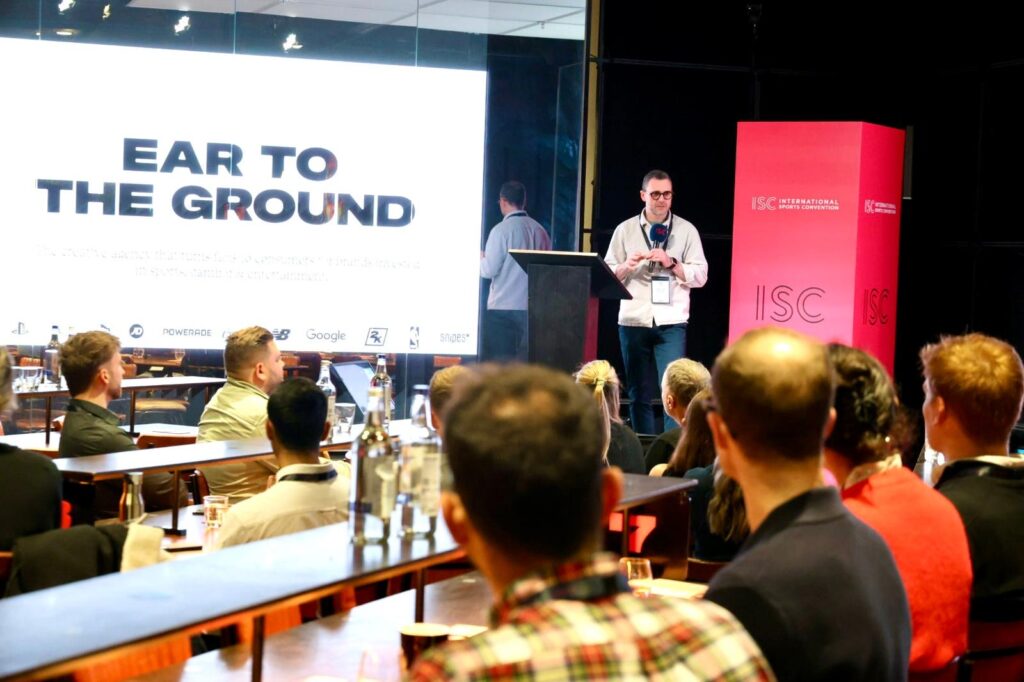Simon Luff began the ISC Fan Engagement Summit with a statement of intent.
“Turning fans into consumers is our mission,” said Ear To The Ground’s Managing Partner and Head of Strategy, “and we do that through creative effectiveness.”
In his opening presentation, Luff billed Ear To The Ground as the only UK-based sports advertising agency accredited for its creative effectiveness by the Institute of Pracitioners in Advertising (IPA). Its approach is expressed not only in campaigns with culture-forward brands like Nike and JD Sports but also a set of independent studies into what really works for those companies in the sports industry.
These are built through its Fan Intelligence Network: an 11,000-strong community of the most connected fans shaping culture from inside and outside the sports marketing space. Working with that group, Ear To The Ground has developed its Fan Attraction Score – its attempt at a Net Promoter Score-style industry-standard measure for brand appeal in sport.
An annual Fan Intelligence Network survey is paired with thousands of hours of in-depth interviews – all of which is then run through a proprietary AI platform called Fan Intelligence AI.
The result is the Fan Index: a yearly ranking of the 100 most culturally effective brands in sport. And the 2025 study also uncovered a key insight for where brands should be showing up for fans.
The Third Space – as defined by Ear To The Ground – is a set of informal on and offline environments – including podcasts and fan-run media and events – where fans reset the terms of their own culture. It sits beyond the ‘first space’ of traditional sports settings and properties and the ‘second space’ of conventional sponsorship activities and branded content.
Brands that chart high in the Fan Index are experts in navigating The Third Space – an area where their presence is not needed by fans but where they can add value to deepen engagement.
Nike and Adidas are the two sports brands in in top ten – both historically effective in starting the cultural conversation. Google is a big mover after integrating its Pixel handsets into some unforgettable on-field moments, while Instagram tops the list after tweaking its platform to deliver a more positive, user-first experience.
Further down the list, successful FMCG, automotive and other consumer brands use exclusive sponsorship rights to develop unique content and experiences. But some culturally potent players, like skatewear company Vans, have become more static after failing to give fans enough scope to play with their brand identity.
Other brands might have a polarising quality – like alcohol brands – or be more focused on their activities in the second space of brand-first communication.
Luff presented ISC delegates with six ‘laws of the Third Space’.
Brands should ‘make memories’ and become integral to them. Netflix, for example, boasts a distinctive cultural imprint and unmistakeable brand signatures, and through its work with sports partners like the NFL and WWE, it is now building viewing experiences that stay with fans on and off the platform.
They should take care to ‘craft your moments’. Here, Luff cited Asics’ ‘move your body, move your mind’ campaign, which took the running label into a very specific and relevant context around wellness and fitness. Snack brand and UEFA Champions League sponsor Lays, meanwhile, has made itself central to the big match experience for fans through its ‘No Lays, No Game’ positioning.
Brands should be prepared to ‘design for the remix’. In other words, Luff explained, companies and platforms must be ready to give fans the tools to shape and use brands in their own image. YouTube is making this easier with a new suite of creator tools; its live-streaming rival Twitch has lost ground by putting caps on usage and storage.
There is an opportunity for brands to ‘get intimate’ by developing rituals that get brand to heart of the fan experience. Premier League sponsor Guinness is a brand with a unique heritage in this respect. More recently, it has enjoyed an organic social media boom through trends like ‘splitting the G’, while its matchday pints are now more inclusive with the rise of its non-alcohol 0.0 line. Conversely, Pepsi’s glossy concert sponsorships and big celebrity campaigns were seen by the Fan Intelligence Network as creating too much distance.
Similarly, brands use talent best when they ‘humanise fame’ and allow their ambassadors to be themselves. Luff explained how Pringles’ grounded, off-kilter and irreverent campaign with Chelsea star Cole Palmer felt more relevant and accessible to brands than Beats’ more conventional spots, which put its sporting icons on a far-off pedestal.
Ultimately, Luff said, it is essential to ‘keep pace’ – scanning for any brand drift and experimenting to stay ahead of trends. Humility and curiosity are crucial; fans will always take the lead. Even those at the cutting edge have lost resonance over time by repeating the same ideas.

